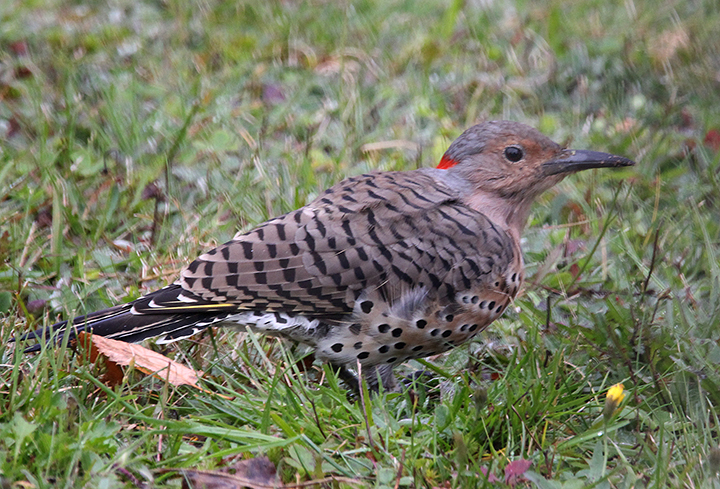A Trip To Northern Maine

PHOTO: A northern flicker searches for insects on the ground in Fort Kent, Maine, last week. Chris Bosak Photograph.

by Chris Bosak
Weirs Times Columnist
My destination was the northern part of Maine. I’m talking way north. Get to Baxter State Park and keep going for several more hours.
I drove pretty much through the night to get there. I took a few half-hour breaks to sleep and then continued on my way. I have been to northern New Hampshire dozens of times, and I have been to the middle of Maine many times. I’ve always wanted to see what Aroostook County was all about so I took the opportunity to head up there and finally see for myself.
I settled at the border town of Fort Kent where only the St. John River separates the U.S. from Canada.
Wildlife, of course, was the driving force behind the decision to drive up there. The boreal forest, to me anyway, is a magical place filled with so many interesting creatures. Moose are my favorite creatures, but things like lynx, loons, eagles, grouse, boreal chickadees, Canada jays, and other specialty species unique through the habitat are also a draw.
Some species, such as spruce grouse, I have never seen, and some animals, such as moose, I haven’t seen in a few years. I figured heading up to the extreme northern part of Maine would give me a good chance at finding both of those animals. I drove along the roads the Internet told me to drive on and added many more miles on unmarked dirt roads and came up empty. I logged thousands of steps through the forest to no avail.
No moose, no spruce grouse. Moose, of course, are dwindling in numbers because of winter ticks and brainworm, but I was hoping to get lucky and be far enough north where the species may not be as heavily impacted. In talking to several locals, moose numbers are hurting just as much up there as they are throughout New Hampshire. I can remember seeing a dozen or more moose on a single trip to northern New Hampshire in the late 1990s. Not so much anymore.
As far as spruce grouse go, I am starting to give up. When I was a beginning birdwatcher living in the Monadnock Region, I could have sworn I saw one in Pisgah State Park, but I have no proof and certainly can not swear by the identification. Pisgah is well south of where spruce grouse are typically seen.
While the wildlife sightings proved to be more scarce than I thought, it wasn’t a complete washout. In the few days I was up there, I did find about a dozen ruffed grouse, several white-tailed deer, a red fox, a Canada jay, a wood duck, a few golden-crowned kinglets, and dozens and dozens of white-throated sparrows.
One other species really stole the show, however. This bird was everywhere up there. They were frequent sightings on the dirt roads, and there were so many of them on the grass in the yard behind my cabin that they reminded me of robins in the spring.
They were northern flickers and at one point I counted 11 of them in the yard, sharing the space with just as many blue jays. Northern flickers are large woodpeckers, but they spend most of their time on the ground searching for ants and other insects. You know it is a northern flicker when it flies off and shows a large white rump patch. We have the yellow-shafted variety in New England. Out West, the red-shafted is the predominant northern flicker.
Northern flickers are one of the few migratory woodpeckers. They do not travel extremely long distances and usually settle in the Carolinas or a bit farther south. I wonder if some of the birds I had seen had nested farther north in Canada and were starting their migration or if they were all residents.
I do know that northern New Hampshire has a healthy population of northern flickers as well. I will always remember the sight of a red fox trotting down Route 3 in Pittsburg, NH, with a northern flicker and its mouth.
I threw a few nuts and seeds out the back door of the cabin to try to lure the blue jays and flickers closer. It took a few days, but they eventually warmed up to the idea and came to eat the treats.
I see plenty of flickers and blue jays in southern New England, but they were a nice treat to watch in northern Maine as well. Like many animal species, the blue jays looked a little more sturdy up there. White-tailed deer seem to be a little more sturdy in northern New England as well.
I didn’t get my moose or spruce grouse, but you can bet I’ll try again next year. The boreal forest always beckons.
Chris Bosak may be reached at chrisbosak26@gmail.com or through his website www.birdsofnewengland.com
